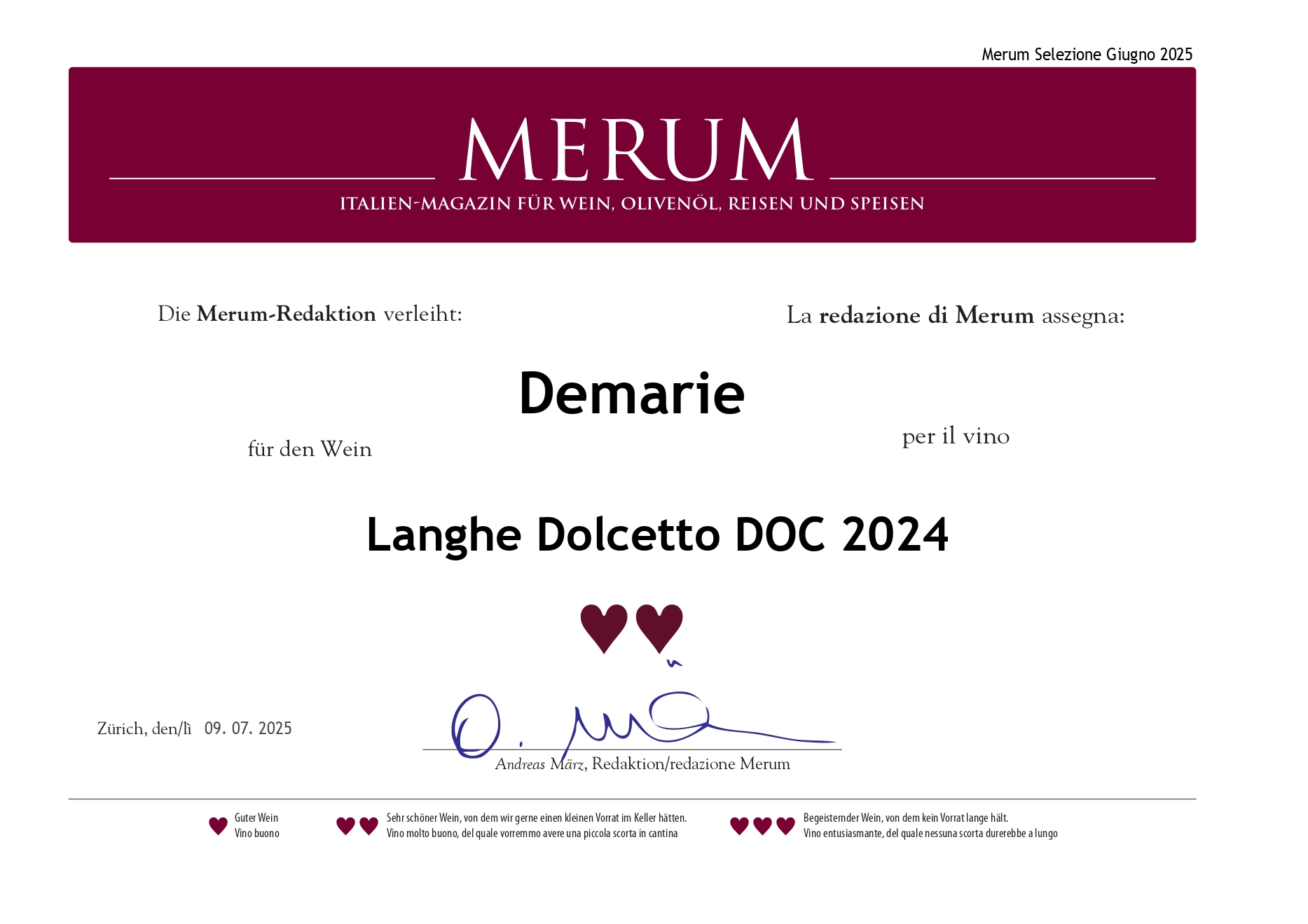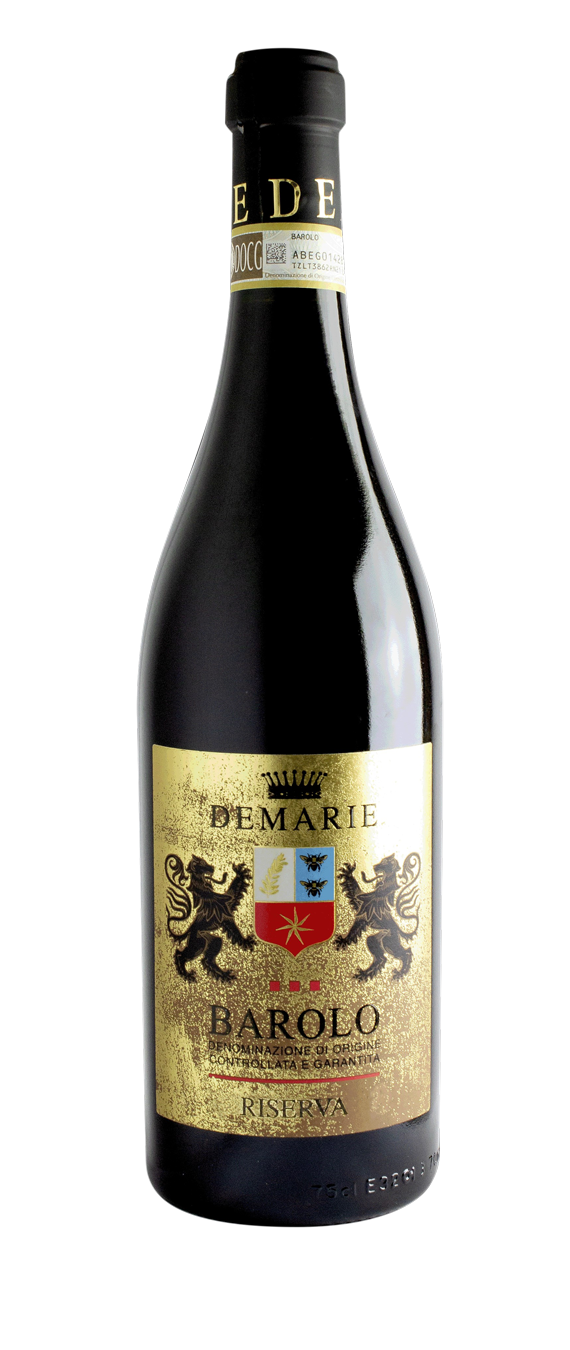Langhe DOC Dolcetto Vintage 2021
Wine
Dolcetto, the “every-day” wine is the all-time favourite with the wine-grower’s family meal.
This is a wine that expresses with great authenticity the simple quiet life of the hard-working Roero winegrower.
The name “Dolce” or gentle would seem to infer the contrary…but its name comes from the hilltops (or “duset” in Piedmont dialect) where like all good vines, the Dolcetto is grown.
Another tradition says the name comes from the fact that when eaten very ripe, Dolcetto grapes are extremely sweet.
The oldest traditional wines are considered among the best to accompany the various dishes that make up a family meal, because of their light well-balanced qualities.
This is a wine whose colour and aroma conjure up the image and flavour of the hills where it is grown.

Tasting Notes
Variety: 100% Dolcetto grapes
Colour: intense ruby, with brilliant reflections and shades of purple
Scent in perfume: wine, typical and pleasant with hints of almond blossoms and violet
Flavour: dry, medium-bodied, harmonious, pleasantly fruity (with nuances of cherry and mulberry), almond aftertaste
Best served at: 15-16° C – 58-60° F
Food matches: wine for all the meal, the ideal companion every day
Vinification: alcoholic and malolactic fermentation in steel tanks
Fining: in steel tanks
Size / Format: 0,75 l
Ageing potential: up to 3 years after the harvest
Merum 2018 — 2 cuori

Guide Merum
Score 2 cuori
Publish Year 2018
Vintage 2024
Langhe Dolcetto DOC 2024
The Merum editorial team awards Demarie 2 hearts for the Langhe Dolcetto DOC 2024
I Vini di Veronelli 2016 — 1 stella

Guide I Vini di Veronelli
Score 1 stella
Publish Year 2016
Langhe DOC Dolcetto 2013
I Demarie coltivano le proprie uve sui soleggiati pendii del Roero attraverso metodi compatibili con la salvaguardia dell’ambiente naturale. I Vigneti si trovano nei comuni di Vezza, Castagnito, Castellinaldo e Guarene, impiantati prevalentemente con Nebbiolo, Barbera ed Arneis.
I Vini di Veronelli 2015 — 2 stelle

Guide I Vini di Veronelli
Score 2 stelle
Publish Year 2015
Langhe Dolcetto DOC 2012
I Demarie coltivano le proprie uve sui soleggiati pendii del Roero attraverso metodi compatibili con la salvaguardia dell’ambiente naturale. I Vigneti si trovano nei comuni di Vezza, Castagnito, Castellinaldo e Guarene, impiantati prevalentemente con Nebbiolo, Barbera ed Arneis.
Annuario dei migliori vini italiani 2014 — 87/100

Guide Annuario dei migliori vini italiani
Score 87/100
Publish Year 2014
Dolcetto Langhe DOC 2012
Pressoché completa la rappresentanza di autoctone uve del Piemonte nel bicchiere Demarie. Versatile il suo viticolo ed enologico vista la diffusa piacevolezza rilevata. Enologia virtuosa che non reca fumosità alla marasca nera del potente Dolcetto Langhe DOC 2012.
I Vini di Veronelli 2014 — 2 stelle

Guide I Vini di Veronelli
Score 2 stelle
Publish Year 2014
Langhe Dolcetto DOC 2012
I Demarie coltivano le proprie uve sui soleggiati pendii del Roero attraverso metodi compatibili con la salvaguardia dell’ambiente naturale. I Vigneti si trovano nei comuni di Vezza, Castagnito, Castellinaldo e Guarene, impiantati prevalentemente con Nebbiolo, Barbera ed Arneis.
I Vini di Veronelli 2013 — 1 stella

Guide I Vini di Veronelli
Score 1 stella
Publish Year 2013
Langhe Dolcetto DOC 2010
I Demarie coltivano le proprie uve sui soleggiati pendii del Roero attraverso metodi compatibili con la salvaguardia dell’ambiente naturale. I Vigneti si trovano nei comuni di Vezza, Castagnito, Castellinaldo e Guarene, impiantati prevalentemente con Nebbiolo, Barbera ed Arneis.
Vine
Dolcetto is a red grape vine, one of the area’s most typical indigenous vine, whose first news dates back to the beginning of the 1500.
It’s not a particularly vigorous plant, nor particular resistant to vine diseases, despite that Dolcetto’s popularity has persisted owing to its versatility: the grapes are good to eat raw or can be cooked to obtain a kind of jam, called ‘cognà’ which is eaten with local cheeses.
And, of course, Dolcetto wine is a simple but delicious product of the local hills.
Historically, it was the wine used for bartering with the peoples of the Ligurian seaboard, in exchange for olive oil, salt and anchovies – which formed the ingredients of one of South Piedmont’s most famous dishes, ‘bagna caoda’.
Dolcetto wine was also taken to the plains of Cuneo and bartered for veal calves which were then raised in Langa hill farms to ensure a plentiful supply of meat.
Dolcetto had its heyday during the 1970s and ‘80s, when vineyards were extended owing to increased demand for the wine in factory canteens.
These days, consumption of Dolcetto has somewhat decreased, although it still remains a staple among local people, who wouldn’t dream of including any other wine on their dinner tables.
The vine’s name derives from the exceptional sweetness of the grape but is misleading as far as the wine is concerned, as this is definitely dry, moderately acidic and possesses a pleasant bitterish after taste.
The vine can give rise to both fresh, light wines capable of adaptation to any meal, or fullerbodied and well-structured ones that tolerate up to seven years of ageing – all according to the area of cultivation and to how they are developed in the winery.
Vineyard & Vintage Features
Langhe DOC Dolcetto 2021
Vineyard
Production area: Comuni del Roero
Farming: traditional – guyot
Kg of grapes per hectare: 100 quintals/hectar
Max wine liters per hectare: 7.000 liters
Chemical Analysis
Alcohol vol. (%): 13 %
Sugar rate: < 4 g/l
Total SO2: < 100 mg/l
Total Acidity: 5,9 g/l
















